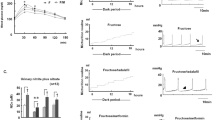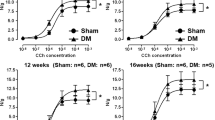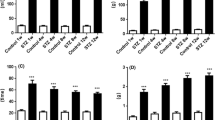Abstract
Purpose
We explored the pathophysiologic mechanisms of long-term fructose-induced lower urinary tract symptoms (LUTS) in rats.
Methods
Male Wistar rats were fed with fructose for 3 or 6 months. Biochemical and transcystometric parameters were compared between fructose-fed and age-matched normal-diet rats. Pelvic nerve and external urethral sphincter-electromyogram activity recordings were performed to investigate fructose effects on neural control of bladders. Mitochondrial structure, ATP and acetylcholine content and purinergic and muscarinic cholinergic receptors were examined. Cytosolic cytochrome C staining by Western blot and immunocytochemistry for mitochondrial injury and PGP 9.5 stain for nerve density were also determined.
Results
The fructose-fed rats with higher plasma triglyceride, LDL and fasting glucose levels displayed LUTS with increased frequency and suppressed voiding contractile amplitude in phase 1 and phase 2 duration versus normal-diet control. Fructose feeding altered the firing types in pelvic afferent and efferent nerves and external urethral sphincter-electromyogram activity. Increased mast cell number, disrupted and swollen mitochondria, increased cytosolic cytochrome C stain and expression and decreased nerve density in bladder smooth muscle layers appeared in the fructose-fed rats. Fructose feeding also significantly reduced ATP and acetylcholine content and enhanced protein expression of postsynaptic P2X1, P2X2 and P2X3 purinergic receptors and M2 and M3 muscarinic cholinergic receptors expression in the smooth muscles of urinary bladder.
Conclusion
Long-term fructose feeding induced neuropathy and myopathy in the urinary bladders. Impaired mitochondrial integrity, reduced nerve density, ATP and acetylcholine content and upregulation of purinergic and muscarinic cholinergic receptors expression may contribute to the bladder dysfunction of fructose-fed animals.







Similar content being viewed by others
Change history
23 March 2024
An Editorial Expression of Concern to this paper has been published: https://doi.org/10.1007/s00394-024-03373-3
References
Kahn R, Buse J, Ferrannini E, Stern M (2005) The metabolic syndrome: time for a critical appraisal: joint statement from the American Diabetes Association and the European Association for the Study of Diabetes. Diabetes Care 28:2289–2304
Rohrmann S, Smit E, Giovannucci E, Platz EA (2005) Association between markers of the metabolic syndrome and lower urinary tract symptoms in the Third National Health and Nutrition Examination Survey (NHANES III). Int J Obes (Lond) 29:310–316
Yu HJ, Lee WC, Liu SP et al (2004) Unrecognized voiding difficulty in female type 2 diabetic patients in the diabetes clinic: a prospective case-control study. Diabetes Care 27:988–989
Lee WC, Wu CC, Wu HP, Tai TY (2007) Lower urinary tract symptoms and uroflowmetry in women with type 2 diabetes mellitus with and without bladder dysfunction. Urology 69:685–690
Bray GA, Nielsen SJ, Popkin BM (2004) Consumption of high-fructose corn syrup in beverages may play a role in the epidemic of obesity. Am J Clin Nutr 79:537–543
Le KA, Tappy L (2006) Metabolic effects of fructose. Curr Opin Clin Nutr Metab Care 9:469–475
Martin SA, Haren MT, Marshall VR et al (2011) Members of the Florey Adelaide Male Ageing Study. Prevalence and factors associated with uncomplicated storage and voiding lower urinary tract symptoms in community-dwelling Australian men. World J Urol 29:179–184
Shen GX (2010) Oxidative stress and diabetic cardiovascular disorders: roles of mitochondria and NADPH oxidase. Can J Physiol Pharmacol 88:241–248
Vincent AM, Hayes JM, McLean LL et al (2009) Dyslipidemia-induced neuropathy in mice: the role of oxLDL/LOX-1. Diabetes 58:2376–2385
Kedi X, Ming Y, Yongping W, Yi Y, Xiaoxiang Z (2009) Free cholesterol overloading induced smooth muscle cells death and activated both ER- and mitochondrial-dependent death pathway. Atherosclerosis 207:123–130
Tong YC, Cheng JT (2007) Alterations of M2,3-muscarinic receptor protein and mRNA expression in the bladder of the fructose fed obese rat. J Urol 178:1537–1542
Chien CT, Yu HJ, Lin TB et al (2003) Substance P via NK1 receptor facilitates hyperactive bladder afferent signaling via action of ROS. Am J Physiol Renal Physiol 284:F840–F851
Chien CT, Yu HJ, Lin TB, Chen CF (2000) Neural mechanisms of impaired micturition reflex in rats with acute partial bladder outlet obstruction. Neuroscience 96:221–230
Palea S, Artibani W, Ostardo E et al (1993) Evidence for purinergic neurotransmission in human urinary bladder affected by interstitial cystitis. J Urol 150:2007–2012
Yokota T, Yamaguchi O (1996) Changes in cholinergic and purinergic neurotransmission in pathologic bladder of chronic spinal rabbit. J Urol 156:1862–1866
Lee WC, Chien CT, Yu HJ, Lee SW (2008) Bladder dysfunction in rats with metabolic syndrome induced by long-term fructose feeding. J Urol 179:2470–2476
Burnstock G (2011) Therapeutic potential of purinergic signalling for diseases of the urinary tract. BJU Int 107:192–204
Lawrence GW, Aoki KR, Dolly JO (2010) Excitatory cholinergic and purinergic signaling in bladder are equally susceptible to botulinum neurotoxin a consistent with co-release of transmitters from efferent fibers. J Pharmacol Exp Ther 334:1080–1086
Yoshimura N, Kaiho Y, Miyazato M et al (2008) Therapeutic receptor targets for lower urinary tract dysfunction. Naunyn Schmiedebergs Arch Pharmacol 377:437–448
Al-Zi’abi MO, Bowolaksono A, Okuda K (2009) Survival role of locally produced acetylcholine in the bovine corpus luteum. Biol Reprod 80:823–832
Yeh CH, Chiang HS, Chien CT (2010) Hyaluronic acid ameliorates bladder hyperactivity via the inhibition of H2O2-enhanced purinergic and muscarinic signaling in the rat. Neurourol Urodyn 29:765–770
Chen MC, Blunt LW, Pins MR, Klumpp DJ (2006) Tumor necrosis factor promotes differential trafficking of bladder mast cells in neurogenic cystitis. J Urol 175:754–759
Yu HJ, Chien CT, Lai YJ et al (2004) Hypoxia preconditioning attenuates bladder overdistension-induced oxidative injury by up-regulation of Bcl-2 in the rat. J Physiol 554:815–828
Lee WC, Chuang YC, Chiang PH et al (2011) Pathophysiological studies of overactive bladder and bladder motor dysfunction in a rat model of metabolic syndrome. J Urol 186:318–325
Girard A, Madani S, Boustani ESE et al (2005) Changes in lipid metabolism and antioxidant defense status in spontaneously hypertensive rats and Wistar rats a diet enriched with fructose and saturated fatty acids. Nutrition 21:240–248
Messier C, Whately K, Liang J et al (2007) The effects of high fat, high fructose, and combination diet on learning, weight, and glucose regulation in 57BL/6 mice. Behav Brain Res 178:139–145
Moura RF, Ribeiro C, Oliveira JA et al (2009) Metabolic syndrome signs in Wistar rats submitted to different high-fructose ingestion protocols. Br J Nutr 101:1178–1184
Sheludiakova A, Rooney K, Boakes RA (2011) Metabolic and behavioural effects of sucrose and fructose/glucose drinks in the rat. Eur J Nutr [Epub ahead of print]
Huang YC, Shindel AW, Ning H et al (2010) Adipose derived stem cells ameliorate hyperlipidemia associated detrusor overactivity in a rat model. J Urol 183:1232–1240
Zhang H, Qiu X, Shindel AW et al. (2011) Adipose tissue-derived stem cells ameliorate diabetic bladder dysfunction in a type II diabetic rat model. Stem Cells Dev [Epub ahead of print]
Sadananda P, Drake MJ, Paton JF, Pickering AE (2011) An exploration of the control of micturition using a novel in situ arterially perfused rat preparation. Front Neurosci 5:62
Latta M, Künstle G, Leist M, Wendel A (2000) Metabolic depletion of ATP by fructose inversely controls CD95- and tumor necrosis factor receptor 1-mediated hepatic apoptosis. J Exp Med 191:1975–1985
O’Reilly BA, Kosaka AH, Knight GF et al (2002) P2X receptors and their role in female idiopathic detrusor instability. J Urol 167:157–164
Cockayne DA, Hamilton SG, Zhu QM et al (2000) Urinary bladder hyporeflexia and reduced pain-related behaviour in P2X(3)-deficient mice. Nature 407:1011–1015
Liu G, Daneshgari F (2005) Alterations in neurogenically mediated contractile responses of urinary bladder in rats with diabetes. Am J Physiol Renal Physiol 288:F1220–F1226
Yoshida M, Miyamae K, Iwashita H et al (2004) Management of detrusor dysfunction in the elderly: changes in acetylcholine and adenosine triphosphate release during aging. Urology 63:17–23
Hegde SS, Mandel DA, Wilford MR et al (1998) Evidence for purinergic neurotransmission in the urinary bladder of pithed rats. Eur J Pharmacol 349:75–82
Juan YS, Chuang SM, Kogan BA et al (2009) Effect of ischemia/reperfusion on bladder nerve and detrusor cell damage. Int Urol Nephrol 41:513–521
Fukagawa NK, Li M, Liang P et al (1999) Aging and high concentrations of glucose potentiate injury to mitochondrial DNA. Free Radic Biol Med 27:1437–1443
Chien CT, Chien HF, Cheng YJ et al (2000) Renal afferent signaling diuretic response is impaired in streptozotocin-induced diabetic rats. Kidney Int 57:203–214
Gabella G (1999) Structure of the intramural nerves of the rat bladder. J Neurocytol 28:615–637
Acknowledgments
This work was supported by the National Science Council of the Republic of China (NSC99-2314-B418-002-MY3 and NSC99-2628-B-002-058-MY3) and research fund from Far-Eastern Memorial Hospital (FEMH-99-D-006).
Conflict of interest
None.
Author information
Authors and Affiliations
Corresponding author
Rights and permissions
About this article
Cite this article
Chung, SD., Chien, CT. & Yu, HJ. Alterations in peripheral purinergic and muscarinic signaling of rat bladder after long-term fructose-induced metabolic syndrome. Eur J Nutr 52, 347–359 (2013). https://doi.org/10.1007/s00394-012-0342-4
Received:
Accepted:
Published:
Issue Date:
DOI: https://doi.org/10.1007/s00394-012-0342-4




